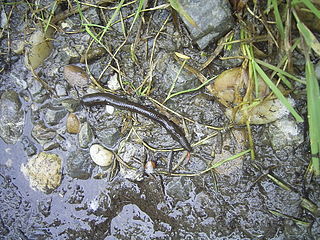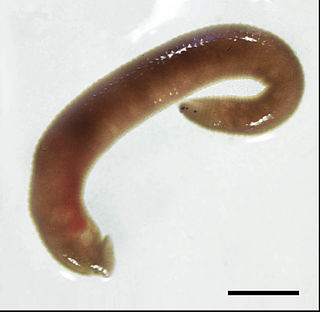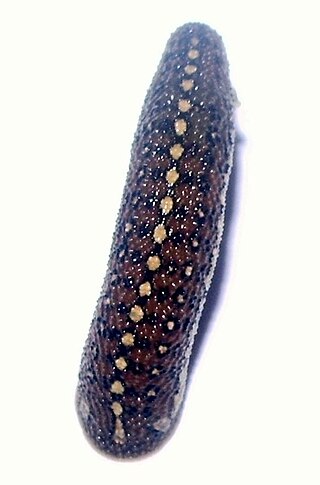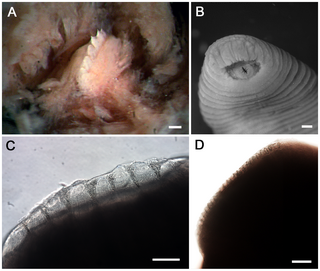
Haemadipsidae are a family of jawed leeches. They are a monophyletic group of hirudiniform proboscisless leeches. These leeches have five pairs of eyes, with the last two separated by two eyeless segments. The family is monotypic, containing only the subfamily Haemadipsinae, though as the family can apparently be divided into two or three distinct lineages, at least one of the proposed splits, while not a distinct family, might be a valid subfamily.
Erpobdella obscura is a freshwater ribbon leech common in North America. It is a relatively large leech and is commonly used as bait by anglers for walleye and other sport fish. In Minnesota, live bait dealers annually harvest over 45,000 kg of bait-leeches, raising concerns of over-harvest.

Arhynchobdellida, the proboscisless leeches, are a monophyletic order of leeches. They are defined by the lack of the protrusible proboscis that defines their sister taxon, the Rhynchobdellida. Arhynchobdellida is a diverse order, compromising both aquatic and terrestrial, besides sanguivorous and predatory, leeches. The order is divided into two suborders, Erpobdelliformes and Hirudiniformes.

The Hirudiniformes are one of the currently-accepted suborders of the proboscisless leeches (Arhynchobdellida). Their best-known member is the European medical leech, Hirudo medicinalis, and indeed most of the blood-sucking "worms" as which leeches are generally perceived belong to this group. In general, though some leeches suck blood, many are predators which hunt small invertebrates.

Leeches are segmented parasitic or predatory worms that comprise the subclass Hirudinea within the phylum Annelida. They are closely related to the oligochaetes, which include the earthworm, and like them have soft, muscular segmented bodies that can lengthen and contract. Both groups are hermaphrodites and have a clitellum, but leeches typically differ from the oligochaetes in having suckers at both ends and in having ring markings that do not correspond with their internal segmentation. The body is muscular and relatively solid, and the coelom, the spacious body cavity found in other annelids, is reduced to small channels.

Xerobdellidae are a small family of jawed leeches in the order Arhynchobdellida. Xerobdellidae have three jaws and five pairs of eyes, the fourth and fifth being separated by one or two eyeless segments. The genera placed herein occur in Chile (Mesobdella), Europe (Xerobdella) and Diestecostoma is found in Central and northern South America. This peculiar distribution strongly suggests they are a relict Pangaean group, which had already been present by the start of the Jurassic 250 million years ago.
Erpobdella lineata is a leech found in Europe. These leeches show a preference for calcic waters and have a tolerance to pollution. They have a digestive tract that consists of mouth, pharynx, esophagus, six-chambered stomach, three-chambered intestine, rectum, and an anus. Its nervous system contains 21 pairs of cell compartments.

Phytobdella catenifera is a large terrestrial leech found in Peninsular Malaysia. John Percy Moore chose this species’ epithet ‘catenifera’ after the striking chain-striped pattern on the creature's back.

Americobdella is a genus of carnivorous leeches from southern Chile, comprising only the species, Americobdella valdiviana.
Motobdella montezuma is a species of leech which is only found in Montezuma Well, central Arizona, United States. It is a nocturnal pelagic predator that feeds almost exclusively on the endemic amphipod Hyalella montezuma, which it detects using passive sonar and swallows whole.

Erpobdella is a genus of leeches in the family Erpobdellidae. Members of the genus have three or four pairs of eyes, but never have true jaws, and are typically 20–50 millimetres (0.8–2.0 in) long. All members do not feed on blood, but instead are predators of small aquatic invertebrates, which they often swallow whole.
Motobdella is a genus of leeches in the family Erpobdellidae. It contains two species:

The Erpobdelliformes are one of the currently-accepted suborders of the proboscisless leeches (Arhynchobdellida). It includes five families:
Erpobdella triannulata is an leech in the Erpobdellidae family.
Erpobdella punctata is a leech in the family Erpobdellidae. It is found in freshwater streams and ponds in many parts of North America.
Erpobdella lahontana is an leech in the Erpobdellidae family.
Dina parva is an annelid in the Erpobdellidae family.

The Piscicolidae are a family of jawless leeches in the order Rhynchobdellida that are parasitic on fish. They occur in both freshwater and seawater, have cylindrical bodies, and typically have a large, bell-shaped, anterior sucker with which they cling to their host. Some of the leeches in this family have external gills, outgrowths of the body wall projecting laterally, the only group of leeches to exchange gases in this way.
Anna J. Phillips is an American Research Zoologist and curator of Clitellata and Cestoda at the National Museum of Natural History's Department of Invertebrate Zoology. As a parasitologist her research focuses on leeches and tapeworms, by studying their diversity, relationships, and host associations. She has traveled all over the world with her fieldwork to study the diversity of these invertebrates on a long range.

Praobdellidae is a family of hematophagous leeches which live on the mucous membranes of mammals and sometimes invertebrates. These are internal parasites that enter the body through natural orifices, and cause hirudiniases.










